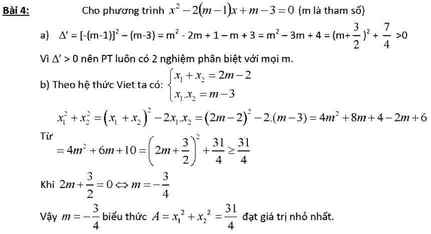Hãy nhập câu hỏi của bạn vào đây, nếu là tài khoản VIP, bạn sẽ được ưu tiên trả lời.

Sửa đề: \(x^2+\left(m+3\right)x+2m+2=0\)
a: Để phương trình có hai nghiệm trái dấu thì 2m+2<0
hay m<-1
b: \(\text{Δ}=\left(m+3\right)^2-4\left(2m+2\right)\)
\(=m^2+6m+9-8m-8\)
\(=m^2-2m+1=\left(m-1\right)^2>=0\)
Do đó: Phương trình luôn có hai nghiệm với mọi m
Để phương trình có hai nghiệm dương phân biệt thì \(\left\{{}\begin{matrix}m-1< >0\\2m+2>0\\m+3>0\end{matrix}\right.\Leftrightarrow\left\{{}\begin{matrix}m>-1\\m< >1\end{matrix}\right.\)

a, Với m=2
\(Pt\Leftrightarrow x^2-8x+9=0\Leftrightarrow\left(x-4\right)^2=7\)
\(\Leftrightarrow\orbr{\begin{cases}x-4=\sqrt{7}\\x-4=-\sqrt{7}\end{cases}}\)\(\Leftrightarrow\orbr{\begin{cases}x=\sqrt{7}+4\\x=-\sqrt{7}+4\end{cases}}\)
Vậy pt có 2 nghiệm phân biệt \(\orbr{\begin{cases}x=\sqrt{7}+4\\x=-\sqrt{7}+4\end{cases}}\)

\(x^2-\left(m+4\right)x+4m=0\) (1)
a)Thay x=2 vào pt (1) ta được: \(4-\left(m+4\right).2+4m=0\) \(\Leftrightarrow m=2\)
Thay m=2 vào pt (1) ta được: \(x^2-6x+8=0\)\(\Leftrightarrow x^2-4x-2x+8=0\)
\(\Leftrightarrow\left(x-4\right)\left(x-2\right)=0\)\(\Leftrightarrow\left[{}\begin{matrix}x=2\\x=4\end{matrix}\right.\)
Vậy nghiệm còn lại là 4
b)Để pt có hai nghiệm pb \(\Leftrightarrow\Delta>0\Leftrightarrow m^2-8m+16>0\)\(\Leftrightarrow\left(m-4\right)^2>0\)\(\Leftrightarrow m\ne4\)
Do x1 là một nghiệm của pt \(\Rightarrow x_1^2-\left(m+4\right)x_1+4m=0\)
\(\Rightarrow x_1^2=\left(m+4\right)x_1-4m=0\)
Theo viet có: \(x_1+x_2=m+4\)
\(x_1^2+\left(m+4\right)x_2=16\)
\(\Leftrightarrow\left(m+4\right)x_1-4m+\left(m+4\right)x_2=16\)
\(\Leftrightarrow\left(m+4\right)\left(x_1+x_2\right)-4m-16=0\)
\(\Leftrightarrow\left(m+4\right)^2-4m-16=0\)
\(\Leftrightarrow m^2+4m=0\)
\(\Leftrightarrow\left[{}\begin{matrix}m=0\\m=-4\end{matrix}\right.\)(Thỏa)
Vậy...

a) Thay \(m=1\) vào phương trình, ta được:
\(x^2+12x-4=0\) \(\Rightarrow\left[{}\begin{matrix}x=-6+2\sqrt{10}\\x=-6-2\sqrt{10}\end{matrix}\right.\)
Vậy ...
b)
+) Với \(m=0\) \(\Rightarrow12x-4=0\) \(\Leftrightarrow x=\dfrac{1}{3}\)
+) Với \(m\ne0\), ta có: \(\Delta'=36+4m\)
Để phương trình có 2 nghiệm phân biệt \(\Leftrightarrow\Delta'>0\) \(\Leftrightarrow m>-9\)
Vậy \(\left\{{}\begin{matrix}m\ne0\\m>-9\end{matrix}\right.\) thì phương trình có 2 nghiệm phân biệt
c) Để phương trình có nghiệm kép \(\Leftrightarrow\Delta'=0\) \(\Leftrightarrow m=-9\)
\(\Rightarrow-9x^2+12x-4=0\) \(\Leftrightarrow x=\dfrac{2}{3}\)
Vậy \(m=-9\) thì phương trình có nghiệm kép \(x_1=x_2=\dfrac{2}{3}\)
d) Để phương trình vô nghiệm \(\Leftrightarrow\Delta'< 0\) \(\Leftrightarrow m< -9\)
Vậy \(m< -9\) thì phương trình vô nghiệm

a, Với m=1 thay vào pt
Ta có
\(x^2+x-1=0\)
\(\Rightarrow\left\{{}\begin{matrix}x=\dfrac{-1+\sqrt{5}}{2}\\x=\dfrac{-1-\sqrt{5}}{2}\end{matrix}\right.\)
b,
Thay x=2 vào pt
ta có
\(4-2-3m+2=0\)
\(\Leftrightarrow4-3m=0\)
\(\Rightarrow m=\dfrac{4}{3}\)
c, Ta có
\(\Delta=1-4\left(-3m+2\right)\)
\(=12m-7\)
Để pt có 2 nghiệm phân biệt thì \(\Delta>0\)
\(\Rightarrow12m-7>0\)
\(\Rightarrow m>\dfrac{7}{12}\)
d,
Để ptcos nghiệm kép thì \(\Delta=0\)
\(\Rightarrow12m-7=0\)
\(\Rightarrow m=\dfrac{7}{12}\)
e,
Để pt vô nghiệm thì \(\Delta< 0\)
\(\Rightarrow m< \dfrac{7}{12}\)